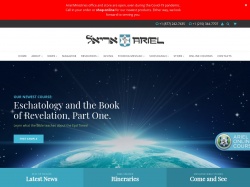God ordained a daily worship service in the Tabernacle called the continual burnt (tamid, תמיד) offering. Every day, the priesthood offered two male lambs as burnt offerings for the daily service.
The continual burnt offering began each morning with a male lamb offered as a burnt offering (olah, עולה). The priests slaughtered a lamb and placed it on the fire of the altar as the first sacrifice of the day. The lamb burned on the fire all day—a continual burnt offering. The priests placed each subsequent sacrifice they made on top of the pyre on which the lamb was burning.
When the day’s service concluded and the priests had completed all the sacrifices for that day, they brought a second lamb. They slaughtered it as an olah and placed it on top of the remains of that day’s offerings, sandwiching the whole day’s services between the two lambs of the continual burnt offering. They left the second lamb on the altar to burn through the night. The next morning, the priests removed the ashes and slaughtered a lamb, placed it on the altar, and started the process all over again. In this way, a lamb remained continually burning on the altar before the LORD.
The continual burnt offering set a baseline pattern as the most basic and regular function of the Tabernacle and the Temple. The prayer services, the singing of psalms, the lighting of the menorah, and the burning of incense all occurred in conjunction with the continual offering. The two lambs of the continual burnt offering, offered at the set times of sacrifice, created the structure upon which the rest of the Temple services hung. To this day, the Jewish times of prayer correspond to the hours at which the continual burnt offering used to be made.
The continual burnt offering commemorated the offering made during the Exodus 24 covenant ceremony at Mount Sinai. It remained continually upon the altar as a permanent token of the covenant. Its blood, splashed daily against the altar, provided a constant reminder of the “blood of the covenant” that Moses applied to the altar and to the people at Mount Sinai.
John the Immerser alluded to the continual burnt offering when he identified Yeshua as “the Lamb of God” (John 1:29).
Why are there two lambs for the daily offering? Perhaps the two lambs allude to Messiah son of Joseph and Messiah son of David. Perhaps the two lambs of the continual burnt offering allude to the first and second coming of our Master Yeshua:
So Messiah also, having been offered once to bear the sins of many, will appear a second time for salvation without reference to sin, to those who eagerly await Him. (Hebrews 9:28)
Tetzaveh – תצוה : “You shall command”
Torah : Exodus 27:20-30:10
Haftarah : Ezekiel 43:10-27
Gospel : Matthew 13:1-53
Source: Torah Portion



